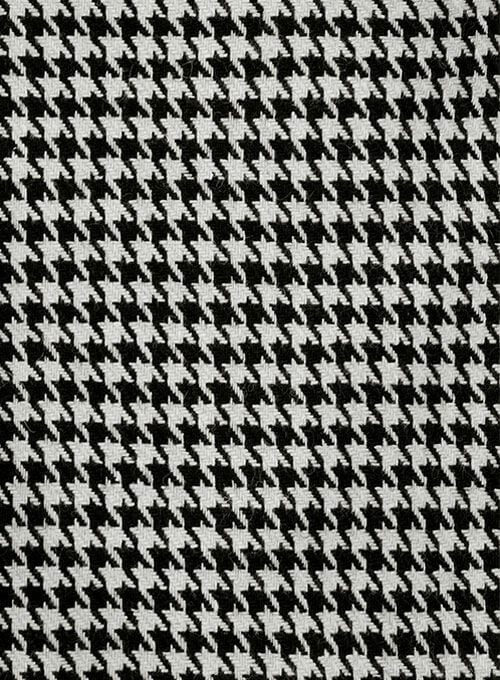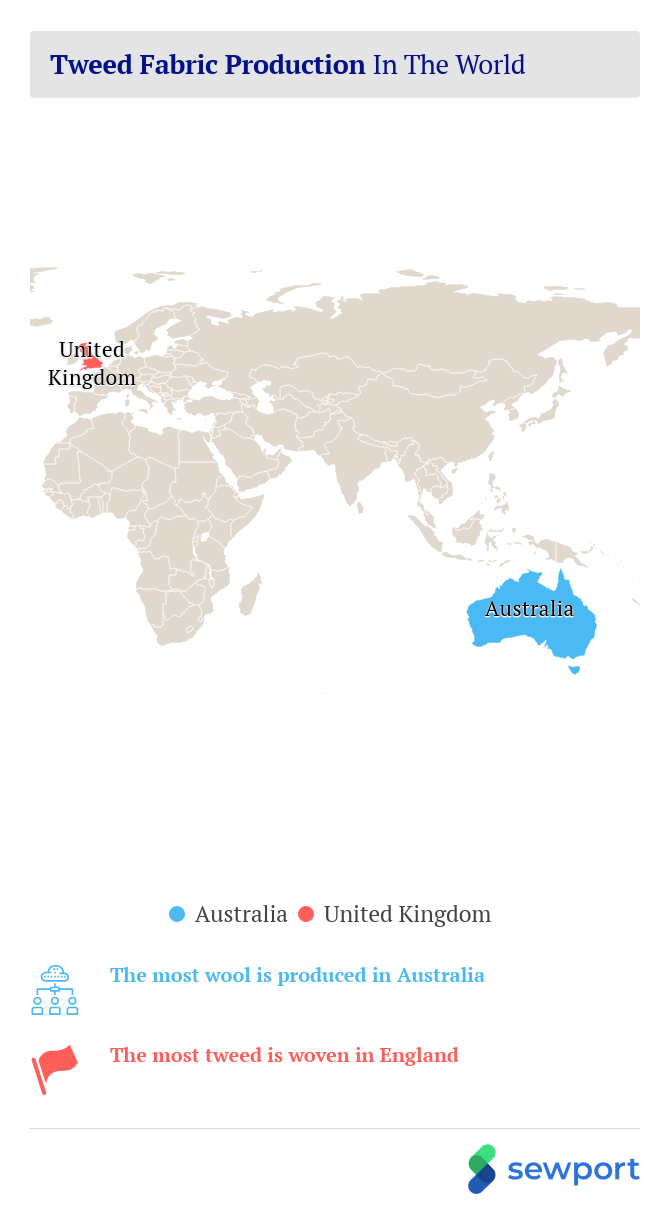| Fabric name | Tweed |
| Fabric also known as | Clò-Mór, the Big Cloth |
| Fabric composition | Coarsely-woven wool yarn (usually sheep) |
| Fabric breathability | Low |
| Moisture-wicking abilities | Medium |
| Heat retention abilities | High |
| Stretchability (give) | Low |
| Prone to pilling/bubbling | High |
| Country where fabric was first produced | Scotland |
| Biggest exporting/producing country today | Australia & England |
| Recommended washing temperatures | Cold - low agitation |
| Commonly used in | Jackets, pants, hats, trench coats, blazers, other outerwear, winter clothing, suit jackets, military uniforms (historically) |
 Big Houndstooth BW tweed jacket
Big Houndstooth BW tweed jacket
What is tweed fabric?
Tweed is a type of wool weave that is designed for weather resistance. Since they’re made from natural wool, each tweed product looks slightly different, which has always added to the allure. By choosing certain sheep breeds instead of others, you can somewhat control the pattern that will emerge in your tweed garment. From there, bunch-dyeing sets the iconic tweed patterns we all know and love.
Since it is coarse and rough to the touch, tweed is usually reserved for use in outerwear. Originally invented by the Scottish, tweed is now an international fashion staple, and the majority of tweed wool is harvested in Australia.
History of tweed
Tweed has ancestrally been used by Scottish shepherds for hundreds of years to fend off the rampaging highland winds. In the early 1800s, this rugged fabric caught the eye of the English aristocracy, and within decades, British nobles were placing large orders of matching, themed tweed garments for their entire staff. As the Industrial Revolution made wool cheaper and easier to produce, tweed found its way to the masses, and this fabric is still used today in outerwear applications.
 Buster Mineral Tweed Fabric
Buster Mineral Tweed Fabric
The tweed flat cap
While tweed was also commonly used in blazers, hunting jackets, and military garb, this fabric’s most iconic historical application was in a unique piece of headwear called the English flat cap. This hat style is synonymous with horseback polo, the fox hunt, and springtime croquet, and flat cap production continues to take up a significant amount of the world’s annual tweed output.
Tweed today
Modern tweed more closely represents the English nobility’s interpretation than it does the original rugged Scottish fabric. Regardless, tweed’s ability to resist the environment has won it an enduring place in the international fashion world, and tweed garments are still made and sold in reasonably large quantities today.
Over time, contemporary inventions like Gore-Tex and polyester fluff have given rise to new outerwear technology that has largely supplanted the necessity of natural fibers. Tweed has, therefore, become more of a niche or nostalgia item than a utilitarian product. It recalls a time when wool, not petrochemicals, were the world’s fiber source of choice. We just might be on the verge of an age in which natural fabrics like tweed make a major comeback.
 Casual Blazer Tweed
Casual Blazer Tweed
Attributes of tweed
Tweed has three main attributes that continue to make this fabric desirable:
1. Weather resistant
Wool naturally repels water, and the thick weave of tweed fends of droplets and deluges all the better.
2. Camouflage
English nobles originally were quite taken with how tweed blended in perfectly with the surrounding countryside. Even today, tweed is beloved for its natural allure.
3. Thick and coarse
 Derby Tweed Suit
Derby Tweed Suit
These attributes make tweed very durable and insulative, which is why this fabric became so popular in winter clothing and outerwear.
The market value of natural fibers like wool
Natural fibers are expensive to produce, which historically led to the prevalence of synthetic fabric worldwide. Unlike petrochemical-based fibers, however, natural fabrics are usually quite heat-resistant. Since it’s mainly made from cellulose, cotton is reasonably flammable, but the natural animal hairs that constitute wool yarn are surprisingly fire-resistant.
If wool does catch on fire, it doesn’t melt, scald, or adhere to the skin in any way. Instead, it simply chars and falls off, and it also doesn’t leave any toxic fumes behind. Combined with the fact that wool is one of the world’s most sustainable fabrics, it’s clear why wool textiles like tweed remain as popular as they are.
How is tweed fabric made?

The tweed fabric production process can be roughly categorized into six steps:
1. Harvesting wool fiber
Merino sheep generally produce a yearly coat. This coat of wool fiber is harvested humanely in most cases, and it is rudimentarily cleaned and packed into bales.
2. Cleaning and spinning
Once taken to the production floor, the wool is cleaned more carefully and carded into long strings. These strings are then spun to make yarn.
3. Dyeing and drying
The wool yarn is dyed in particular colors and dried in bunches. The ratio of certain dye colors to each other is balanced perfectly to result in the exact tweed pattern that’s desired.
 Fetterangus estate tweed fabric
Fetterangus estate tweed fabric
4. Blending and mixing
After the yarn is roughly mixed by hand, it’s loaded into an industrial mixer to produce the desired pattern.
5. Teasing and carding
The dyed wool yarn is carded again. Designed to be thick, finished tweed yarn consists of a few reasonably-wide wool yarns all spun together.
6. Weaving
Once the thick tweed thread has been made, it is woven into garments.
How is tweed fabric used?

Tweed remains frequently used in a variety of weather-resistant product categories:
Tweed in apparel
- Hunting jackets
- Blazers
- Coats
- Military jackets
- Trench coats
- Womens coats
- Pants
- Suit jackets
Tweed in accessories
- Flat caps
- Irish flat caps
- Newspaper boy caps
Where is tweed fabric produced?

The most wool is produced in Australia, but the most Tweed is woven in England:
Wool production
Australia is the world’s largest producer of wool. Sheep took very well to this southern continent and its neighbor, the much geographically-smaller New Zealand. While the sheep-to-kiwi ratio is even higher than the sheep-to-Aussie ratio, Oz wins in terms of sheer land mass, which makes it the world’s biggest sheep paradise by far.
Tweed weaving
The majority of tweed weaving takes place in the UK, which makes the Austrialian wool trade an important facet of the relationship between these two Commonwealth countries.
How much does tweed fabric cost?
A variety of factors influence the end cost of tweed fabric:
 Lock X Harris Tweed Grouse rollable hat
Lock X Harris Tweed Grouse rollable hat
1. Inherent priciness of natural fibers
It’s only “natural” that natural fibers cost more. Petroleum is cheap and plentiful, and wool and cotton are hard to harvest. At the same time, oil won’t be cheap forever, and sheep will always have a place on Earth’s fertile plains.
2. Decreased popularity of tweed
Since tweed is in less demand, producers have to increase prices to make ends meet. At the same time, it’s also easier than ever before to find cheap tweed since this fabric is mainly machine-manufactured.
3. Type of sheep used
While high-end wools like cashmere aren’t commonly used to make tweed, even regular merino wool has a variety of quality grades.
4. Quality of weave
Some tweed has been dyed and woven the same way for nearly two centuries, and other tweed manufacturers just got into the business recently to make a buck. You get what you pay for in the tweed market.
What different types of tweed fabric are there?

Over the years, a plethora of distinct tweed varieties have emerged:
1. Overcheck
The checks on overcheck tweed are nothing like the small, simple checkered patterns you’re used to. Instead, each check is just an outline, and it covers about four square inches of fabric. This pattern can be overlaid on top of other tweed patterns.
2. Twill
Twill has a simple, diagonal pattern. It’s the most common type of tweed fabric.
3. Herringbone
Herringbone has an iconic triangular pattern with varying tones. This pattern is more common in tweed than it is in any other fabric.
4. Checked
Checked tweed has the typical checkerboard pattern that’s so common in many types of apparel.
5. Striped
True to its name, striped tweed is bedecked with either horizontal or (usually) vertical stripes.
 Police Tweed Flatcap Thin Blue Line CT189S0S6TY
Police Tweed Flatcap Thin Blue Line CT189S0S6TY
6. Estate
The term “estate tweed” usually refers to a herringbone pattern overlaid with a checked pattern. It’s more common in hats than it is in other tweed products.
7. Barleycorn
This type of tweed is named for its similarity in appearance to barley grains, which are sometimes called corns.
8. Plaid
While some of the other tweed types in this list might be unfamiliar, surely you’ve heard of plaid.
9. Houndstooth
Houndstooth is one of the most unassuming tweed patterns, and it’s named for its similarity to dogs’ teeth.
How does tweed fabric impact the environment?
Wool is one of the most sustainable textile fibers. It does very little damage to the environment, but there are certain ways that the global wool industry could be improved. Here’s a breakdown of all the good and bad ways tweed production might impact the environment:
Sheep land use
Some would argue that sheep degrade land and harm ecosystems. In all fairness, however, it’s not the sheep doing it—it’s the humans raising them. Sheep aren’t inherently bad for land, they just need to be moved around from time to time to make sure they don’t erode soil or cause any other environmental harm.
Sheep waste
Yes, sheep emit flatulence, and yes, that flatulence contains methane. Just how sheep farts are responsible for climate change is still up for debate, but regardless, it’s possible that both sheep flatulence and excrement might do environmental damage.
Animal rights concerns
Traditionally, wool sheep haven’t been treated all that well. After the outcry of global animal rights activist groups, however, the industry has cleaned itself up significantly. Remember that it’s always possible to get sheep wool that was cultivated with ancestral, nomadic practices if 100% authentic and organic is just how you roll.
Lack of major pollutants
Cotton production requires pesticides and fertilizers, and petrochemical-based products wreak unspeakable havoc upon ecosystems around the world. Sheep farts aside, wool production doesn’t introduce any significant quantities of pollutants into the environment, and this practice is so sustainable that it has been successfully pulled off for thousands of years with no major consequences.
Biodegradability
Despite being durable, wool is highly biodegradable. If you leave a wool garment and a polyester garment out in the rain, wind, and snow for a hundred years, the wool will have disappeared and the polyester will remain.
Tweed fabric certifications available
Woolmark is the world’s most respected certifier of wool products.
